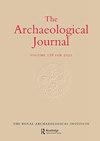The original plan for Hadrian’s Wall: a new purpose for Pons Aelius?
IF 0.8
0 ARCHAEOLOGY
引用次数: 2
Abstract
ABSTRACT Several major issues remain around the eastern end of Hadrian’s Wall, due partly to the dense urban fabric of Tyneside. These concern the spacing of the interval structures in the first seven Wall miles, the course of the mural barrier in Newcastle, the purpose of the Roman bridge over the river Tyne (Pons Aelius) and the original eastern terminus of the Wall. This paper retraces the anchor points of our knowledge before zooming in to examine the Wall’s northern approach of the Tyne bridge and considering a possible new departure. Seeing the crucial role of river crossings in determining not just the line of the Wall but also the successive work sectors, the question is raised how far the Wall on Tyneside may originally have been planned to mirror the situation in the west. Before long, however, the project was overhauled, and effectively redesigned, in consequence of the so-called ‘fort decision’ and all the related changes, one of them concerning the Wall’s eastern terminus. Understanding the infancy of Roman Britain’s mural barrier requires exploring the eventful context in which this imperial prestige project took shape, got mixed up conceptually and was set right again around AD 122.哈德良长城的最初计划:庞斯·埃利乌斯的新目的?
哈德良长城东端仍然存在几个主要问题,部分原因是泰恩赛德密集的城市结构。这些问题涉及到前七英里长城中间隔结构的间距、纽卡斯尔壁画屏障的路线、泰恩河(Pons Aelius)上罗马桥的用途以及长城最初的东部终点。本文回顾了我们的知识的锚点,然后放大到检查墙的泰恩桥的北部途径,并考虑一个可能的新的出发。鉴于河流过境点不仅决定了长城的界线,而且决定了随后的工作区域,人们提出了一个问题,泰恩赛德的长城最初计划在多大程度上反映了西部的情况。然而,不久之后,由于所谓的“堡垒决定”和所有相关的变化,该项目进行了大修,并进行了有效的重新设计,其中一项涉及长城的东部终点。要了解罗马不列颠壁画屏障的萌芽阶段,就需要探索这个帝国威望工程形成、概念混淆并在公元122年左右被重新修复的重大背景。
本文章由计算机程序翻译,如有差异,请以英文原文为准。
求助全文
约1分钟内获得全文
求助全文

 求助内容:
求助内容: 应助结果提醒方式:
应助结果提醒方式:


